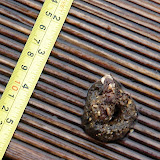It is pretty clear that, whatever happens, the wood will not just stay as it is now. The question for us is to what extent we intervene in its development. I must say, I am pulled two ways: regenerating the ancient woodland; and dropping choice exotics into it. I wonder if both can be done; and I suppose they can, if one is fairly rigorous about where the dropping is done.
Of course, there are huge temptations: draping clematis or climbing hydrangeas or climbing roses over dead stumps; introducing perennial flowering plants into the woodland: aquilegias, geraniums in the open spaces, astrantia, anemone; putting the odd exotic tree or shrub under the protection of the tree cover: rhododendrons, mainly; and adding exotic trees: liriodendron, swamp cypress, whatever else might survive the long and sometimes harsh, but perhaps less harsh than formerly, winters.
Then there is the temptation of growing things to eat, particularly soft fruit.
Obviously, we have already interfered with the landscape quite a lot. So I don't feel embarrassed at the idea of trying some of the wild daffodil types in a drift on one of the raw banks, or putting an exotic tree or shrub near the house.
I have mentioned bog plants for the places where raw peat has been exposed. I am also wondering what might survive on the dry banks. Miniature wild magenta gladioli, anyone?
Any ideas or opinions out there?





